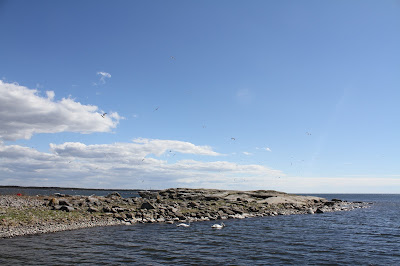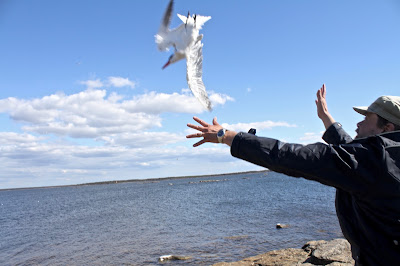The end of May is high time for incubation amongst the Caspian Terns of the Baltic. So with this knowledge in hand I headed for Ostrobothnia, to the Kristinestad archipelago to meet up with the resident tern expert and collaborator, Patrik Byholm. This archipelago has a markedly high density of breeding Caspian terns with a colony of about 70 breeding pairs and some 25 solitary breeding pairs in the area.
 |
| The Kristinestad archipelago boasts a nice diversity of the classic
Baltic seabirds such as Common Eiders, Ruddy Turnstones, and
White-tailed Eagles as well as healthy contingency of the
ever-charismatic Little Gull |
The goal of the trip was to catch adult terns for the attachment of GPS-GSM loggers for revealing migration and habitat use movements. To begin the season we had 4 birds with working tags returning and setting up their breeding attempts, each on their respective islands. So our task was to catch the un-tagged partners of these tagged individuals to be able to then later tag the young as well to hopefully get the successful migratory movements of an entire family group. Exciting stuff, but first things first we had to catch the un-tagged partners. To our good fortune a newly formed pair of terns just so happened to be two birds that were already tagged! Two-birds-one-stone kind of luck!
 |
| Ingströmsberget;
a rather typical breeding island for a solitary pair of Caspian Terns.
Other inhabitants include Great Black-backed Gulls, and Barnacle Geese. |
The first day out was an unequivocal success, with both the un-marked adults being captured and tagged. This was a relief as capturing the right individual on the first attempt greatly reduces the stress for all parties involved.
 |
| Patrik releases our first individual Caspian Tern of the season, complete with a new GSM backpack. |
Not all days are made for sea-faring! This is especially true when the work involves landing on exposed islands in high winds. So our off days were spent in the forest checking a collection of pygmy-owl boxes that Patrik had set up back when he was still in high school. This provided a wonderful opportunity to take full advantage of my time and build a broad perspective the bird life of the region, from the eider of the outermost islands, to the red-breasted flycatcher of the innermost forest patches. A welcomed contrast!
 |
| A partial clutch of few day old pygmy owl nestlings. The large feathers
are leftovers from avian prey brought back to the nest by the male.
These end up becoming insulating nest-lining!) |
When the sun returned, as did we to the sea. We continued surveying islands for possible Caspian Tern breeding activity and also set up a remote camera on the colony island of Gubbstenen. These cameras allow for remote re-sighting of ringed adults breeding on the colony, as well as identification of predation events by eagles, ravens and the like.
 |
| The remote camera gets settled in amongst the breeding terns of the Gubbstenen colony. |
In the last few days of my time in the archipelago we had 2 loggers left to deploy so we decided to try and capture a new pair. We identified an apparently solitary breeding pair on an island that seemed to lend itself to expedient trapping. So we gave it a shot. The first day went without a hitch, with the target bird captured and the tag deployed. Thereafter the pair was given a days rest so as to avoid disturbing their incubation too much. Upon our subsequent return to the island we realized that the pair was in fact not alone on the island but that two other pairs had set up shop and laid eggs! It had become a veritable mini-colony. With the title of ‘solitary pair’ defenestrated, we decided the information would be of no less value and went ahead and captured the remaining partner of the original pair.
 |
| A GPS-GSM logger that will communicate with the cellular network to
provide information on the birds whereabouts is looped around bird’s
legs and loose ends are sewed up for secure fitting. |
With all GPS-units deployed and many amazing birds and environments observed I hopped on the ferry back to Sweden, where other tern-inhabited archipelagos beckoned!
 |
| Baltic glory |
- Martin Beal



Inga kommentarer:
Skicka en kommentar